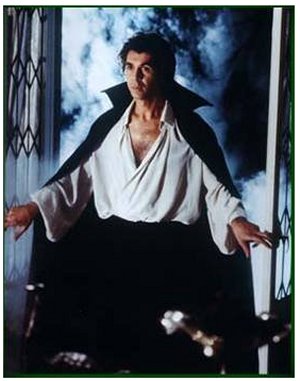In observance of that autumn spell when we celebrate the primal, compulsive instinct of fear, Rainestorm highlights 31 days of spooky scares to season the eerie atmosphere of Halloween.

Reign of terror: 1979

The horror… the horror: As iconic as Bela Lugosi’s performance is, Tod Browning’s Dracula is a rather drab affair, unimproved by Philip Glass’s post hoc score. Hammer Studios bloodier Draculas were an atmospheric improvement but they veered much too far from the source material. John Badham’s late-70s update falls somewhere in between. Attempting to quasi-modernize the tale, he sets it in the early 20th rather than late 19th century and begins the action with Dracula’s arrival in England. This is perhaps the first major motion picture to portray the character as a tragic, romantic loner rather than a maleficent demon. Frank Langella takes his lauded stage performance to the screen along with the legendary Lawrence Olivier as Van Helsing, with Donald Pleasance and Kate Nelligan augmenting the already considerable acting pedigree. Though James Bond title designer Maurice Binder’s unfortunate laser show love scene is ridiculously dated and out of place, the rest of the film is magnificently designed and shot by Peter Murton and Gilbert Taylor, respectively.
Halloween haunt: Murton’s production design is beautifully bleak, with the entire affair unfolding in the gloomy English countryside. Much of the action takes place in Dr. Seward’s grim sanitarium, which is as dank and dreary as Dracula’s gothic castle. Like Fright Night‘s Jerry Dandridge, Langella’s Dracula seems able to create his own fog to use at will.
Tastiest treat: Van Helsing comes face-to-face with his horrifyingly undead daughter.
Check the candy for: Van Helsing sees the approach of said daughter via her reflection in a pool of water, though vampires are unable to cast any reflection.
Devilish discourse: “Sacrilege. SACRILEGE!”
Goes great with: Brides of Dracula (1960). Arguably the best of the Hammer Studios Dracula movies, though Dracula himself makes no appearance in the film. Hammer Horror veteran Terence Fisher sets a typically ominous atmosphere, and Peter Cushing becomes the horror version of Rambo as vampire hunter Van Helsing.


2 responses to “31 Nights, 31 Frights: Dracula”
You will of course disagree, but Herzog’s 1979 remake of Nosferatu is the ultimate 70’s vampire film. Though Topor’s overhanded acting makes for a terrible Renfield, there are sequences in this film that are downright magical, such as this:
Start at 2:22 for beginning of the Wagner sequence if you like)
The film has real gypsies, a real bat (probably the only vampire film to have this–and in beautiful slow motion) and the gorgeous Isabelle Adjani.
Trailer
Actually, I think that Wagner sequence is a prime example of a score mismatching the narrative, not to mention the cinematography and editing. I kept expecting the actors to tell the orchestra to pipe down already. I don’t remember a great deal from my one and only viewing of Nosferatu except it seemed a technical mess, especially in contrast to Fitzcarraldo. The sound design (or editing/effects) was dreadful and the entire movie looked and sounded as though it were a filmed stage play